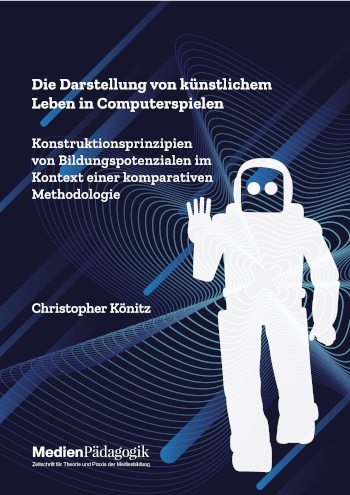Abstract
What if? Through media representations, certain technical and social problems can be represented and reflected. In this respect the study will examine which educational theoretical potentials are opened up by the representation of artificial life forms in computer games. Building on the developed comparative methodology, the study will illustrate and examine how it works. The study will deal with the question of the representation of artificial life forms in computer games in seven parts. In the first part, the concept of artificial life and its relevance in scientific-ethical terms as well as in the context of media representations and especially in the mode of science fiction will be examined. In the second part, the Mass Effect trilogy, which represents the empirical starting point for the study, will be reconstructed with regard to the game world and the story presented, using gamemaps. In the third part of the study, the mediality of the Mass Effect trilogy is examined. Here, general structural features will be elaborated, which are relevant for the coding processes and the understanding of the structural differences between the three games of the trilogy. In the fourth part, I will present and explain the category system that emerged from the open coding. Following this, these categories and properties will be connected into a representational profile of the artificial life forms in the Mass Effect trilogy. This is intended to make the object-relatedness of the categories and properties visible and to outline those essential artificial life forms that have contributed to the results of the study. In doing so, essential structural aspects of the representation of these artificial life forms will also be included. In the fifth part of the study, the essential structural phenomena in the context of the shown artificial life forms will be elaborated. These connect at the prerequisites, mechanisms and processes on the micro-level of the games. Then, in the sixth part of the study, the central structural phenomenon and the associated educational potentials will be elaborated. The seventh part of the study will summarise and discuss the results. This will be followed by an outlook on possible extensions and further developments of the study.
References
Adami, Christoph. 1998. Introduction to Artificial Life. Springer Science & Business Media. https://doi.org/10.1109/TEVC.1998.738989.
Altman, Rick. 1984. «A Semantic/Syntactic Approach to Film Genre». Cinema Journal 23 (3): 6. https://doi.org/10.2307/1225093.
Arendt, Hannah. 2018. Vita activa oder Vom tätigen Leben. 19. Aufl. Piper. München Berlin Zürich: Piper.
Bettinger, Patrick. 2018. «Medien in Bildungsprozessen – Akteur-Netzwerk- und medientheoretische Grundlegung im Anschluss an die praxeologische Bildungstheorie». In Praxeologische Medienbildung: theoretische und empirische Perspektiven auf sozio-mediale Habitustransformationen, 67–150. Wiesbaden: Springer Fachmedien Wiesbaden. https://doi.org/10.1007/978-3-658-21849-2_4.
Buxmann, Peter, und Holger Schmidt. 2019. «Grundlagen der Künstlichen Intelligenz und des Maschinellen Lernens». In Künstliche Intelligenz: Mit Algorithmen zum wirtschaftlichen Erfolg, herausgegeben von Peter Buxmann und Holger Schmidt, 3–19. Berlin, Heidelberg: Springer. https://doi.org/10.1007/978-3-662-57568-0_1.
Damberger, Thomas, und Stefan Iske. 2017. «Quantified Self aus bildungstheoretischer Perspektive». In Das umkämpfte Netz, herausgegeben von Ralf Biermann und Dan Verständig, 17–36. Wiesbaden: Springer Fachmedien Wiesbaden. https://doi.org/10.1007/978-3-658-15011-2_2.
Friedman, Batya, und Helen Nissenbaum. 1996. «Bias in Computer Systems». ACM Transactions on Information Systems 14 (3): 330–347. https://doi.org/10.4324/9781315259697-23.
Herzog, Volker. 2010. «Zellbiologie und Lebensentstehung: vom Molekül zur Zelle». In Lebensentstehung und künstliches Leben, herausgegeben von W Alt, U Eibach, V Herzog, S Schleim, und G Schütz, 17–159. Die Graue Edition.
James, Chris. 2015. EA has pulled Mass Effect Infiltrator and Dead Space from the App Store. https://www.pocketgamer.com/articles/067414/ea-has-pulled-mass-effect-infiltrator-and-dead-space-from-the-app-store/.
Jörissen, Benjamin, und Winfried Marotzki. 2009. Medienbildung – Eine Einführung: Theorie – Methoden – Analysen. 1. Aufl. Stuttgart: UTB. https://doi.org/10.36198/9783838531892.
Knoepfler, Paul. 2018. «Eugenik und Transhumanismus». In Genmanipulierte Menschheit, herausgegeben von Paul Knoepfler und Claudia Wiesemann, 159–194. Berlin, Heidelberg: Springer. https://doi.org/10.1007/978-3-662-56001-3_7.
Knorr, Alexander. 2011. Cyberanthropology. ed. Trickster. Wuppertal: Hammer.
Köchy, Kristian. 2012. «Sind die Überlegungen von Hans Jonas Sonderstatus biologischer Technik angesichts der Entwicklung in der Synthetischen Biologie noch haltbar?» In Konzepte des Humanen: ethische und kulturelle Herausforderungen, herausgegeben von Mariacarla Gadebusch Bondio und Hania Siebenpfeiffer, 81–101. Verlag Karl Alber.
Lessig, Lawrence. 1999. Code and other laws of cyberspace. New York: Basic Books.
Marotzki, Winfried, und Benjamin Jörissen. 2008. «Wissen, Artikulation und Biographie: Theoretische Aspekte einer Strukturalen Medienbildung». In Pädagogische Medientheorie, herausgegeben von Johannes Fromme und Werner Sesink, 51–70. Wiesbaden: VS Verlag für Sozialwissenschaften / GWV Fachverlage GmbH Wiesbaden. https://doi.org/10.1007/978-3-531-90971-4_4.
Peuker, Birgit. 2010. «Akteur-Netzwerk-Theorie (ANT)». In Handbuch Netzwerkforschung, herausgegeben von Christian Stegbauer und Roger Häußling, 325–335. Wiesbaden: VS Verlag für Sozialwissenschaften. https://doi.org/10.1007/978-3-531-92575-2_29.
Rettberg, Jill Walker. 2014. Seeing ourselves through technology: how we use selfies, blogs and wearable devices to see and shape ourselves. London: Palgrave Macmillan UK. https://doi.org/10.1057/9781137476661.
Searle, John S. 2002. «Geist, Gehirn, Programm». In Künstliche Intelligenz: Philosophische Probleme, herausgegeben von Walther Ch Zimmerli, 232–265. Stuttgart: Reclam.
Siekmann, Jörg H. 1994. «Künstliche Intelligenz». In Geist, Gehirn, künstliche Intelligenz, herausgegeben von Sybille Krämer, 203–222. Walter de Gruyter. https://doi.org/10.1515/9783110850505.203.
Spiegel, Simon. 2007. Die Konstitution des Wunderbaren. Zu einer Poetik des Science-Fiction-Films. Schüren. https://doi.org/10.5167/uzh-107405.
Strauss, Anselm L, und Juliet M Corbin. 1996. Grounded theory: Grundlagen qualitativer Sozialforschung. Weinheim: Beltz.
Todorov, Tzvetan. 2018. Einführung in die fantastische Literatur. 2. Aufl. Wagenbachs Taschenbuch. Berlin: Verlag Klaus Wagenbach.
Watson, Richard. 2014. 50 Schlüsselideen der Zukunft. Berlin, Heidelberg: Springer. https://doi.org/10.1007/978-3-642-40744-4.

